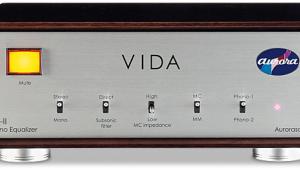Clearaudio Nano Phono (£255+)

A quick glance at Clearaudio’s product range shows that the company prides itself on using quality materials to house its audio electronics, and the Nano Phono certainly continues in this vein. Its case is formed from a solid CNC-machined aluminium block which makes the Nano feel surprisingly heavy, despite its diminutive size. It’s also the cheapest phono stage in Clearaudio’s stable, although with embossed logos, chamfered edges and not a screw-head in sight, there’s nothing ‘entry level’ about its look and feel.
Within the Nano’s case reside dual mono circuits using surface-mount op-amps, confirmed by separate left and right channel switches for MM/MC selection, input loading and low frequency filtering. Both moving-magnet and moving-coil inputs have variable gain [see Lab Report] which is controlled by the rotary dial on the Nano’s top.As well as the default 47kohm, the Nano also offers loading options of 50, 200, 400ohm and 1kohm for MC cartridges, achieved by inserting supplied resistors into sockets on the Nano’s base. If utilised, the resistors may protrude from the Nano’s underside but it’s possible to carefully bend them flat.
For tonearm cable earthing, Clearaudio includes its own 4mm banana plug. Power is via a supplied 16V AC wall-wart transformer and our review model came with the optional front headphone socket (£15 extra) – although contrary to Clearaudio’s claims, plugging in a pair of cans does not automatically mute the RCA outputs.
LION HEARTED
For such a little fellow, sonically the Nano has the heart of a lion and gives its all in every performance. Initially, I found it underwhelming; however, dialling up the gain seemed to coax it out of its shell, and at close to full gain the Nano delivered a soundstage that was strong and forward sounding. This also brought noticeable improvements across the lower registers, particularly with the Benz cartridge. The bass guitar on the Neil Young album, for example, had increased weight and body on ‘Out On The Weekend’, although there remained a slightly woolly quality in comparison to the bass clarity that the Lehmann and Creek delivered. Vocals were helped by the Nano’s solid midband and the lower sung notes of Antony’s performance on ‘Spiralling’ had convincing power.
Of our three cartridges, the Benz seemed to be the Nano’s preferred companion, especially with detail retrieval. A high-output MC, it was configured through the MM setting, which suggested that the Clearaudio is better matched to a high rather than low output cartridge. With the Shiraz, background noise rose and instrument separation on ‘Spiralling’ became increasingly more clouded as the track reached its complex finale. The Clearaudio delivered consistent results across all musical genres, although the excitement faded slightly with Respighi piece, mainly with the horn sections.
Originally published in the January 2012 issue




















































